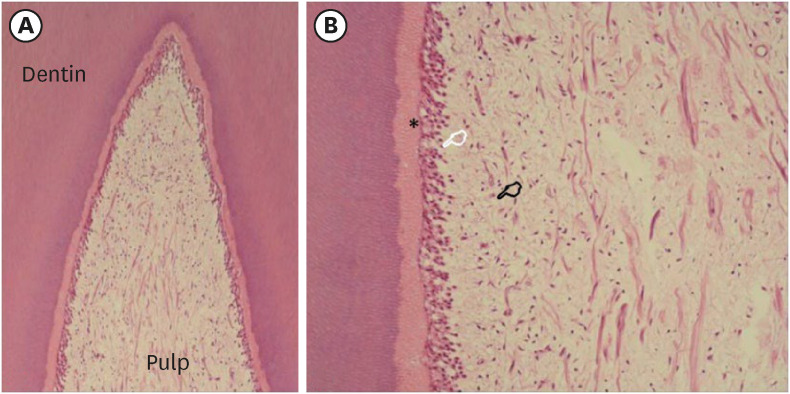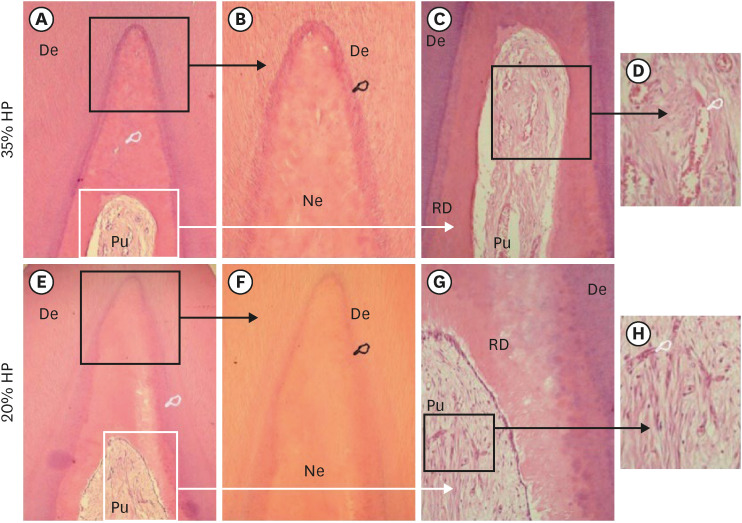Restor Dent Endod.
2023 May;48(2):e12. 10.5395/rde.2023.48.e12.
Effect of medium or high concentrations of in-office dental bleaching gel on the human pulp response in the mandibular incisors
- Affiliations
-
- 1Department of Restorative Dentistry, School of Dentistry, State University of Ponta Grossa, Ponta Grossa, PR, Brazil
- 2Department of Restorative Dentistry, School of Dentistry, Campos Gerais Higher Education Center - CESCAGE, Ponta Grossa, PR, Brazil
- 3Department of Operative Dentistry, Endodontics and Dental Materials, Bauru School of Dentistry, University of São Paulo, Bauru, SP, Brazil
- 4Department of Physiology and Pathology, Araraquara School of Dentistry, São Paulo State University, Araraquara, SP, Brazil
- KMID: 2548215
- DOI: http://doi.org/10.5395/rde.2023.48.e12
Abstract
Objectives
The present study evaluated the pulp response of human mandibular incisors subjected to in-office dental bleaching using gels with medium or high concentrations of hydrogen peroxide (HP).
Materials and Methods
The following groups were compared: 35% HP (HP35; n = 5) or 20% HP (HP20; n = 4). In the control group (CONT; n = 2), no dental bleaching was performed. The color change (CC) was registered at baseline and after 2 days using the Vita Classical shade guide. Tooth sensitivity (TS) was also recorded for 2 days post-bleaching. The teeth were extracted 2 days after the clinical procedure and subjected to histological analysis. The CC and overall scores for histological evaluation were evaluated by the Kruskal-Wallis and Mann-Whitney tests. The percentage of patients with TS was evaluated by the Fisher exact test (α = 0.05).
Results
The CC and TS of the HP35 group were significantly higher than those of the CONT group (p < 0.05) and the HP20 group showed an intermediate response, without significant differences from either the HP35 or CONT group (p > 0.05). In both experimental groups, the coronal pulp tissue exhibited partial necrosis associated with tertiary dentin deposition. Overall, the subjacent pulp tissue exhibited a mild inflammatory response.
Conclusions
In-office bleaching therapies using bleaching gels with 20% or 35% HP caused similar pulp damage to the mandibular incisors, characterized by partial necrosis, tertiary dentin deposition, and mild inflammation.
Keyword
Figure
Reference
-
1. Theobald AH, Wong BK, Quick AN, Thomson WM. The impact of the popular media on cosmetic dentistry. N Z Dent J. 2006; 102:58–63. PMID: 16986302.2. Kwon SR, Wertz PW. Review of the mechanism of tooth whitening. J Esthet Restor Dent. 2015; 27:240–257. PMID: 25969131.
Article3. Reis A, da Silva LM, Martins L, Loguercio A. In-office tooth whitening. Clin Dent Rev. 2018; 2:1–8.
Article4. Maran BM, Vochikovski L, Hortkoff DR, Stanislawczuk R, Loguercio AD, Reis A. Bleaching sensitivity with a desensitizing in-office bleaching gel: a randomized double-blind clinical trial. Quintessence Int. 2020; 51:788–797. PMID: 32901243.5. Vaez SC, Correia A, Santana TR, Santana M, Peixoto AC, Leal PC, Faria-E-Silva AL. Is a single preliminary session of in-office bleaching beneficial for the effectiveness of at-home tooth bleaching? A randomized controlled clinical trial. Oper Dent. 2019; 44:E180–E189. PMID: 30849011.
Article6. de Geus JL, Wambier LM, Kossatz S, Loguercio AD, Reis A. At-home vs in-office bleaching: a systematic review and meta-analysis. Oper Dent. 2016; 41:341–356. PMID: 27045285.
Article7. Mena-Serrano AP, Garcia E, Luque-Martinez I, Grande R, Loguercio AD, Reis A. A single-blind randomized trial about the effect of hydrogen peroxide concentration on light-activated bleaching. Oper Dent. 2016; 41:455–464. PMID: 27352147.
Article8. Reis A, Kossatz S, Martins GC, Loguercio AD. Efficacy of and effect on tooth sensitivity of in-office bleaching gel concentrations: a randomized clinical trial. Oper Dent. 2013; 38:386–393. PMID: 23327226.
Article9. Cooper JS, Bokmeyer TJ, Bowles WH. Penetration of the pulp chamber by carbamide peroxide bleaching agents. J Endod. 1992; 18:315–317. PMID: 1402591.
Article10. Roderjan DA, Stanislawczuk R, Hebling J, Costa CA, Reis A, Loguercio AD. Response of human pulps to different in-office bleaching techniques: preliminary findings. Braz Dent J. 2015; 26:242–248. PMID: 26200147.
Article11. Costa CA, Riehl H, Kina JF, Sacono NT, Hebling J. Human pulp responses to in-office tooth bleaching. Oral Surg Oral Med Oral Pathol Oral Radiol Endod. 2010; 109:e59–e64.12. Vaz MM, Lopes LG, Cardoso PC, Souza JB, Batista AC, Costa NL, Torres ÉM, Estrela C. Inflammatory response of human dental pulp to at-home and in-office tooth bleaching. J Appl Oral Sci. 2016; 24:509–517. PMID: 27812622.
Article13. Roderjan DA, Stanislawczuk R, Hebling J, da Souza Costa CA, Soares DG, Reis A, Loguercio AD. Histopathological features of dental pulp tissue from bleached mandibular incisors. J Mater Sci Eng B. 2014; 4:178–185.14. de Oliveira Duque CC, Soares DG, Basso FG, Hebling J, de Souza Costa CA. Influence of enamel/dentin thickness on the toxic and esthetic effects of experimental in-office bleaching protocols. Clin Oral Investig. 2017; 21:2509–2520.
Article15. Soares DG, Ribeiro AP, da Silveira Vargas F, Hebling J, de Souza Costa CA. Efficacy and cytotoxicity of a bleaching gel after short application times on dental enamel. Clin Oral Investig. 2013; 17:1901–1909.
Article16. Bersezio C, Martín J, Angel P, Bottner J, Godoy I, Avalos F, Fernández E. Teeth whitening with 6% hydrogen peroxide and its impact on quality of life: 2 years of follow-up. Odontology. 2019; 107:118–125. PMID: 29961213.
Article17. Ferraz NK, Nogueira LC, Neiva IM, Ferreira RC, Moreira AN, Magalhães CS. Longevity, effectiveness, safety, and impact on quality of life of low-concentration hydrogen peroxides in-office bleaching: a randomized clinical trial. Clin Oral Investig. 2019; 23:2061–2070.
Article18. Carneiro TS, Favoreto MW, Bernardi LG, Bandeca MC, Borges C, Reis A, Loguercio AD. Application tip and concentration of a self-mixing bleach: hydrogen peroxide inside the pulp chamber, color change, and amount of bleaching gel used. Oper Dent. Forthcoming. 2023.
Article19. Maran BM, Matos TP, de Castro AD, Vochikovski L, Amadori AL, Loguercio AD, Reis A, Berger SB. In-office bleaching with low/medium vs. high concentrate hydrogen peroxide: a systematic review and meta-analysis. J Dent. 2020; 103:103499. PMID: 33068711.
Article20. Mena-Serrano AP, Parreiras SO, do Nascimento EM, Borges CP, Berger SB, Loguercio AD, Reis A. Effects of the concentration and composition of in-office bleaching gels on hydrogen peroxide penetration into the pulp chamber. Oper Dent. 2015; 40:E76–E82. PMID: 25535786.
Article21. de Lourdes Rodrigues Accorinte M, Reis A, Dourado Loguercio A, Cavalcanti de Araújo V, Muench A. Influence of rubber dam isolation on human pulp responses after capping with calcium hydroxide and an adhesive system. Quintessence Int. 2006; 37:205–212. PMID: 16536148.22. de Souza Costa CA, Lopes do Nascimento AB, Teixeira HM, Fontana UF. Response of human pulps capped with a self-etching adhesive system. Dent Mater. 2001; 17:230–240. PMID: 11257296.
Article23. Kawamoto K, Tsujimoto Y. Effects of the hydroxyl radical and hydrogen peroxide on tooth bleaching. J Endod. 2004; 30:45–50. PMID: 14760908.
Article24. Cintra LT, Benetti F, Ferreira LL, Gomes-Filho JE, Ervolino E, Gallinari MO, Rahal V, Briso AL. Penetration capacity, color alteration and biological response of two in-office bleaching protocols. Braz Dent J. 2016; 27:169–175. PMID: 27058379.
Article25. Benetti F, Gomes-Filho JE, Ferreira LL, Ervolino E, Briso AL, Sivieri-Araújo G, Dezan-Júnior E, Cintra LT. Hydrogen peroxide induces cell proliferation and apoptosis in pulp of rats after dental bleaching in vivo: Effects of the dental bleaching in pulp. Arch Oral Biol. 2017; 81:103–109. PMID: 28500951.
Article26. Marson FC, Gonçalves RS, Silva CO, Cintra LT, Pascotto RC, Santos PH, Briso AL. Penetration of hydrogen peroxide and degradation rate of different bleaching products. Oper Dent. 2015; 40:72–79. PMID: 24828134.
Article27. Soares DG, Basso FG, Hebling J, de Souza Costa CA. Concentrations of and application protocols for hydrogen peroxide bleaching gels: effects on pulp cell viability and whitening efficacy. J Dent. 2014; 42:185–198. PMID: 24239924.
Article28. Caviedes-Bucheli J, Ariza-García G, Restrepo-Méndez S, Ríos-Osorio N, Lombana N, Muñoz HR. The effect of tooth bleaching on substance P expression in human dental pulp. J Endod. 2008; 34:1462–1465. PMID: 19026874.
Article29. Huynh MP, Yagiela JA. Current concepts in acute pain management. J Calif Dent Assoc. 2003; 31:419–427. PMID: 12839235.
Article30. Cohen SC. Human pulpal response to bleaching procedures on vital teeth. J Endod. 1979; 5:134–138. PMID: 296253.
Article31. Robertson WD, Melfi RC. Pulpal response to vital bleaching procedures. J Endod. 1980; 6:645–649. PMID: 6935372.
Article32. Kina JF, Huck C, Riehl H, Martinez TC, Sacono NT, Ribeiro AP, Costa CA. Response of human pulps after professionally applied vital tooth bleaching. Int Endod J. 2010; 43:572–580. PMID: 20456515.
Article33. Haywood VB. Treating sensitivity during tooth whitening. Compend Contin Educ Dent. 2005; 26(Supplement 3):11–20.
- Full Text Links
- Actions
-
Cited
- CITED
-
- Close
- Share
- Similar articles
-
- In-office dental bleaching with violet light emitting diode: bleaching efficacy and pulpal temperature rise
- A clinical evaluation of safety of an office bleaching gel containing 30% hydrogen peroxide
- Can different agents reduce the damage caused by bleaching gel to pulp tissue? A systematic review of basic research
- The effect of various commercially available bleaching agents on the microshear bond strength of composite resin to enamel
- Surface Damage and Bleaching Effect according to the Application Type of Home Tooth Bleaching Applicants



